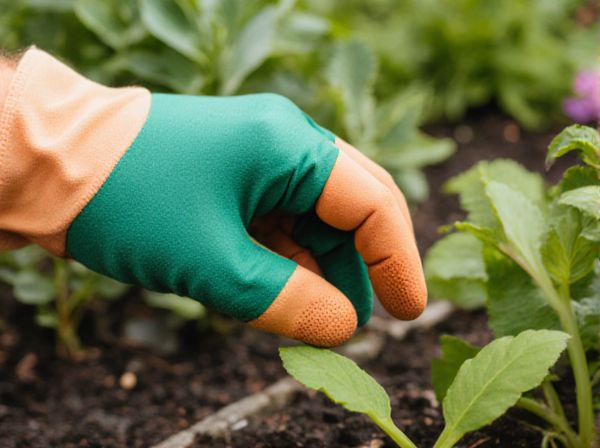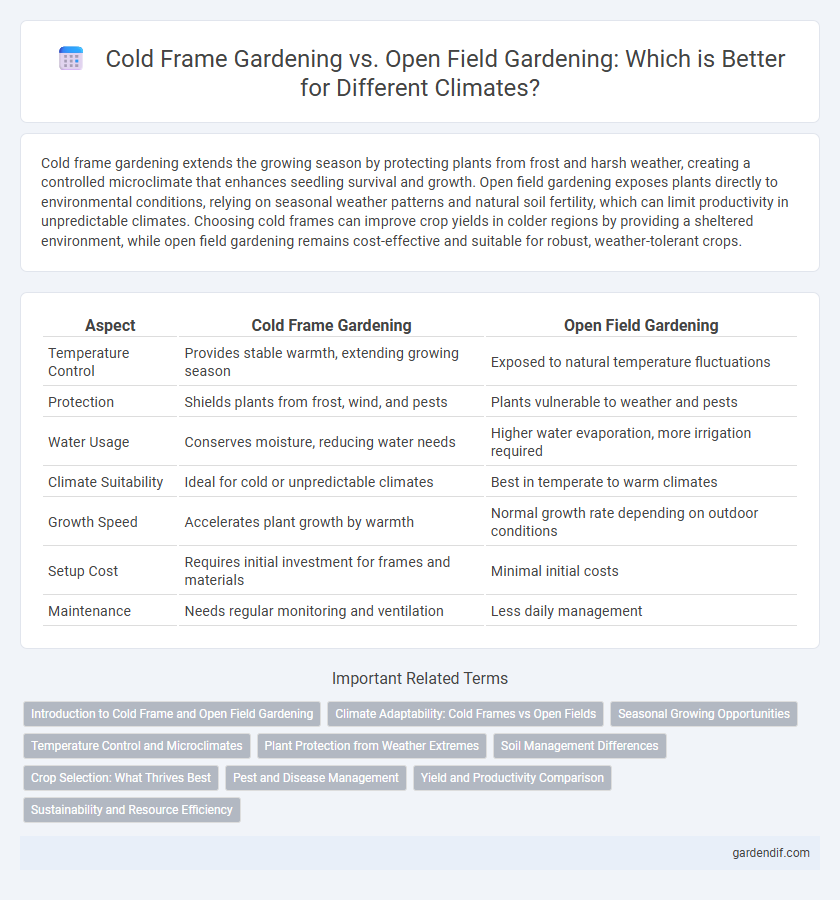
Cold Frame Gardening vs Open Field Gardening Illustration
Cold frame gardening extends the growing season by protecting plants from frost and harsh weather, creating a controlled microclimate that enhances seedling survival and growth. Open field gardening exposes plants directly to environmental conditions, relying on seasonal weather patterns and natural soil fertility, which can limit productivity in unpredictable climates. Choosing cold frames can improve crop yields in colder regions by providing a sheltered environment, while open field gardening remains cost-effective and suitable for robust, weather-tolerant crops.
Table of Comparison
| Aspect | Cold Frame Gardening | Open Field Gardening |
|---|---|---|
| Temperature Control | Provides stable warmth, extending growing season | Exposed to natural temperature fluctuations |
| Protection | Shields plants from frost, wind, and pests | Plants vulnerable to weather and pests |
| Water Usage | Conserves moisture, reducing water needs | Higher water evaporation, more irrigation required |
| Climate Suitability | Ideal for cold or unpredictable climates | Best in temperate to warm climates |
| Growth Speed | Accelerates plant growth by warmth | Normal growth rate depending on outdoor conditions |
| Setup Cost | Requires initial investment for frames and materials | Minimal initial costs |
| Maintenance | Needs regular monitoring and ventilation | Less daily management |
Introduction to Cold Frame and Open Field Gardening
Cold frame gardening utilizes transparent, protective structures that trap solar energy, creating a microclimate ideal for early seed starting and extending the growing season in cooler climates. Open field gardening involves cultivating crops directly in natural soil exposed to ambient weather conditions, relying on seasonal cycles and climatic variations without artificial protection. Understanding these methods helps optimize plant growth by balancing environmental control with natural exposure.
Climate Adaptability: Cold Frames vs Open Fields
Cold frame gardening offers superior climate adaptability by creating a controlled microenvironment that extends the growing season and protects plants from frost, wind, and temperature fluctuations. In contrast, open field gardening exposes crops directly to variable weather conditions, limiting planting windows and increasing vulnerability to climate stressors. This makes cold frames particularly advantageous for regions with short growing seasons or unpredictable climate patterns.
Seasonal Growing Opportunities
Cold frame gardening extends the growing season by providing a controlled microclimate that protects plants from frost, allowing for earlier planting and later harvesting compared to open field gardening. In contrast, open field gardening depends entirely on natural weather conditions, limiting the growing period to frost-free months. By using cold frames, gardeners can cultivate cool-season crops such as lettuce, spinach, and radishes during early spring and late fall, optimizing seasonal growing opportunities.
Temperature Control and Microclimates
Cold frame gardening offers superior temperature control by creating a microclimate that traps solar heat, allowing plants to thrive in cooler weather and extend the growing season. Open field gardening depends on natural weather conditions, exposing crops to temperature fluctuations and increased risk of frost damage. The insulated environment of cold frames mitigates temperature extremes, fostering consistent plant growth and reducing vulnerability to climate variability.
Plant Protection from Weather Extremes
Cold frame gardening provides superior protection against weather extremes by creating a controlled microclimate that shields plants from frost, wind, and heavy rain, enhancing growth during unpredictable climate conditions. In contrast, open field gardening exposes plants directly to temperature fluctuations, frost damage, and excessive moisture, increasing the risk of plant stress and crop loss. Utilizing cold frames extends the growing season and improves plant resilience against harsh weather events.
Soil Management Differences
Cold frame gardening offers superior soil temperature control by trapping heat, promoting faster microbial activity and nutrient availability compared to open field gardening where soil is exposed to fluctuating weather conditions. The enclosed environment minimizes soil erosion and nutrient leaching, maintaining optimal moisture levels for root development. In contrast, open field gardening requires more frequent soil amendments and careful timing to mitigate temperature stress and preserve soil structure.
Crop Selection: What Thrives Best
Cold frame gardening excels in growing cool-season crops like lettuce, spinach, and radishes, which benefit from the controlled warmth and protection against frost. Open field gardening supports a broader variety of crops, including heat-loving plants such as tomatoes, peppers, and beans, that require direct sunlight and extensive space. Selecting crops based on climate and season ensures optimal growth, with cold frames extending the growing window for delicate or early-season plants.
Pest and Disease Management
Cold frame gardening offers enhanced pest and disease management by creating a controlled environment that limits exposure to insects and pathogens common in open field gardening. The enclosed structure reduces the risk of fungal infections and soil-borne diseases while allowing for easier monitoring and targeted intervention. Conversely, open field gardening is more vulnerable to pests such as aphids, caterpillars, and fungal diseases, requiring frequent use of organic or chemical treatments to protect crops.
Yield and Productivity Comparison
Cold frame gardening enhances yield and productivity by extending the growing season and protecting plants from harsh weather, resulting in earlier and more consistent crop production. In contrast, open field gardening relies solely on natural climate conditions, often leading to lower and less predictable yields due to exposure to pests, temperature fluctuations, and weather extremes. Studies indicate that cold frame gardens can increase crop yield by as much as 30-50% compared to open field methods, making them a more efficient choice for maximizing productivity in variable climates.
Sustainability and Resource Efficiency
Cold frame gardening enhances sustainability by reducing water usage through improved moisture retention and minimizing the need for chemical pesticides via natural pest barriers. Open field gardening often demands higher resource inputs, including increased water and synthetic fertilizers, which can contribute to soil degradation and higher carbon footprints. Utilizing cold frames extends growing seasons and optimizes land use efficiency, supporting eco-friendly practices and conserving natural resources.
Cold Frame Gardening vs Open Field Gardening Infographic

 gardendif.com
gardendif.com